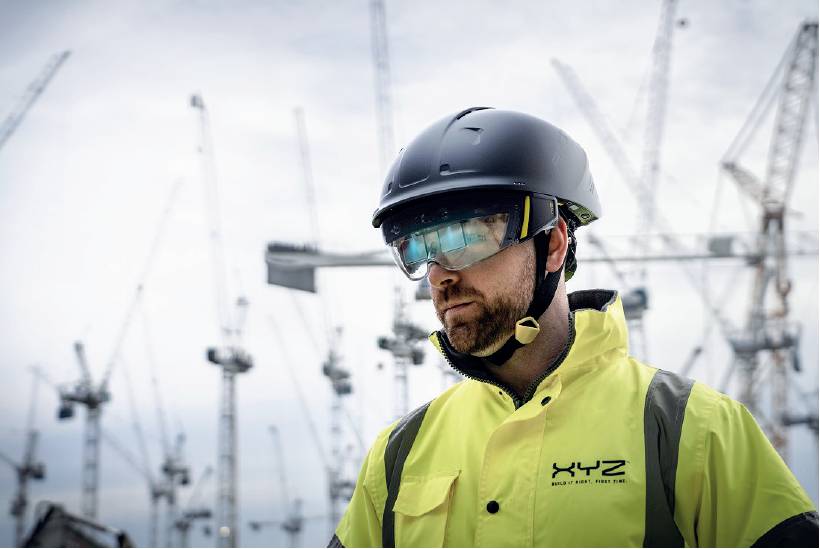Digital innovation is paving the way for sustainable construction
David Mitchell, Founder and CEO, XYZ Reality

THE ongoing climate crisis has cast a renewed light on the importance of sustainability across the globe. Estimated to be responsible for around 38%1 of carbon emissions worldwide, there’s no doubt there is still a great deal the construction industry must do to reduce carbon to an acceptable level and meet net zero 2050 targets.
However, without a more united and collaborative effort to implement more sustainable practices, this figure will continue to increase.
Fortunately, global governments are taking the lead and influencing change, increasing pressure on the sector through green legislation and regulation, including the Environment Act 20212, with its to reduce emissions, pollution and waste.
It’s a good starting point but needs to go further, turning policy intention into substantial, positive results.
There’s ample opportunity for on-site technologies to play an even greater part in delivering more sustainable projects, particularly in minimising waste created through error and subsequent reworkI believe the construction technology sector has an important role to play in achieving this lowcarbon future, particularly through proving the efficacy of digital innovation to support greener ways of working.
Encouragingly, we have seen significant growth in support for new technology as, according to industry analysis by McKinsey3, investors contributed $25bn to engineering and construction technology from 2014 to 2019. A figure that is expected to largely grow in the coming years.
New and improved technologies like BIM and construction quality management (CQM) software have already allowed engineers to increase the efficiency of processes.
Yet, there’s still ample opportunity for on-site technologies to play an even greater part in delivering more sustainable projects, particularly in minimising waste created through error and subsequent rework.
Interoperability improves efficiency

The sharing of connected data and information now plays an essential role in mission-critical construction projects, particularly for monitoring emission levels and informing effective ways of reducing them. By breaking down siloes and connecting them in a wider ecosystem, engineers are better informed and can work with greater efficiency and precision whilst consuming less resource.
For example, by connecting design tools such as BIM and digital devices used on-site, like our own augmented reality (AR) headset, the Atom4, to your construction management platform, it’s driving up accuracy, visibility and efficiency. Considerably reducing the margin for error through interoperability, it’s lowering carbon whilst increasing productivity through more streamlined, intuitive processes, like being able to validate in real-time as work is happening.
It’s lowering carbon whilst increasing productivity through more streamlined, intuitive processes, like being able to validate in real-time as work is happeningWhat’s even better, it’s not a difficult scenario to achieve. At the most basic level, plug-and-play collaborative file management platforms that merge technologies already at our disposal are readily available.
For example, we’ve recently combined the Atom with Autodesk’s construction cloud platform, BIM 360. Proving the power of interoperable tech, this integration is enabling construction teams to make changes in real-time to holographic renders.
By working collaboratively with the site teams, XYZ engineers act as an extension to their team, coordinating issues and ensuring the most recent data is received instantly, in real-time. Ultimately, this is improving accuracy, preventing rework5 and, as a result, reducing waste.
As a means to save time in the short-term, firms and practices should foster interoperability between tech assets, progressing towards a greener sector through greater operational agility.
Innovations so far
Construction has been subject to considerable technological advancements over the past decade. Innovations like digital asset information management (AIM) platforms are becoming well-established within the whole project lifecycle, and in an increasingly digital age, the ability to collate, manage and analyse big data has become invaluable. Essentially, these systems can give engineers correct and comprehensive information on waste levels and expenditure so they can work more effectively, empowering to identify potential errors or delays ahead of time and prevent them.
Businesses need to develop and implement clear sustainability strategies that incorporate wider-reaching environmental, social and governance (ESG) criteria.With an excess of AI-backed software at our disposal, we have already started to revolutionise processes that monitor waste levels. In turn, this is enhancing the operational effectiveness of different assets used throughout projects, increasing efficiency and improving levels of sustainability.
We have also seen the integration of internet of things-enabled hardware tackle ongoing issues within construction, including rework. As previously mentioned, engineering-grade AR is allowing engineers to achieve unrivalled accuracy, resulting in fewer defects, leading to lower waste, higher quality and more sustainable construction.
Looking at the bigger picture
Implementing sustainable change in construction is a challenge that extends beyond the build itself. Behind the scenes, businesses also need to develop and implement clear sustainability strategies that incorporate wider-reaching environmental, social and governance (ESG) criteria.

A holistic approach encompassing all these elements is critical to sustainability goal setting, allowing businesses to monitor performance and make strategic improvements where necessary.
Laying out clear objectives also means civil practices can ensure they’re on track to achieving net zero targets.
Future investors, against the backdrop of the ongoing climate crisis, will want to see businesses that push sustainability and have produced comprehensive records of activities to show they’re doing all they can to reduce their environmental impact.
This means taking considerable care in the development of their sustainability strategies.
As we approach a pinnacle breaking point not just within construction but in human history, those in the industry must align with the growing green agenda.
Legally binding regulations will no doubt fuel this transition, and more is needed. For the good of our environment and society, we all have a part to play in reducing carbon emissions, and digital adoption holds many of the keys.
The closer we get to the 2030 and 2050 targets, the greater the role digital solutions will play.
The potential is huge, it’s now about taking action and harnessing it as effectively as possible.
David Mitchell, Founder and CEO, XYZ Reality
www.xyzreality.com @xyz_reality
1 www.worldgbc.org/thecommitment
2 www.legislation.gov.uk/ukpga/2021/30/contents/enacted
5 www.xyzreality.com/insights/solving-the-construction-rework-problem-how-to-prevent-errors